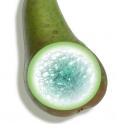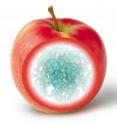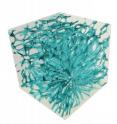Comparing apples and pears
Pears and apples contain air pathways to "breathe". The pathways are microscopically small structures for oxygen supply and are key elements in determining the fruit's health. Researchers from the Catholic University of Leuven in Belgium and the European Synchrotron Radiation Facility (ESRF) have visualized them for the first time, therefore proving their hypothesized existence. In apples, the pathways appear as irregular cavities between cells, whilst in pears they have the shape of tiny interconnected channels. These results allow a better understanding of how the fruit degrades after harvest and provide a scientific explanation of the everyday experience that pears are more susceptible to decay during storage. Apples and pears continue to "breathe" after picking. To keep the fruit healthy, a minimum level of oxygen must be supplied to all cells of the fruit. If this does not happen, internal browning disorders appear and fruit quality decreases. This is why fruit is stored in dedicated cool rooms with accurate control of oxygen levels. The correct oxygen concentration is related to the complex mechanisms of gas exchange, respiration and fermentation in the fruit.
The correct oxygen concentration is related to the complex mechanisms of gas exchange, respiration and fermentation in the fruit. Restricted gas exchange leads to too low a level of oxygen inside the cells. Three-dimensional images of the fruit microstructure help to determine and explain gas exchange rates and when fruit cells start to die and browning initiates. Such imaging is not easy as fruit contains a lot of water and the resolution and contrast of conventional medical 3-D scanners is insufficient.
The Leuven team used the European Synchrotron Radiation Facility in Grenoble to perform tomographic imaging of fruit samples. As the researchers report in the recent issue of Plant Physiology, the powerful equipment produces 3-D images that are accurate down to and below 1/1000 of a millimeter, with sufficient contrast to separate out void spaces from cells. The images are now used in computer models to calculate oxygen concentration in individual cells of fruit tissues.
"It is still unclear how airways in the fruit develop, and why apples have cavity structures and pears micro-channel networks", explains Pieter Verboven, from the Catholic University of Leuven and corresponding author of the paper. However, the results do help explain why pears are so prone to decay during storage: "The micro-channels are so small that oxygen supply to the fruit core is very limited and cells are quickly 'out of breath' when oxygen levels fall below the safety threshold", he asserts.
Source: European Synchrotron Radiation Facility
Other sources
- Apples beat pears on crunch issuefrom BBC News: Science & NatureFri, 11 Jul 2008, 11:35:12 UTC
- Comparing apples and pears: Scientists see health-determining air paths in fruitfrom PhysorgThu, 10 Jul 2008, 17:35:22 UTC
- Apples And Pears Contain Pathways To 'Breathe'from Science DailyThu, 10 Jul 2008, 16:28:13 UTC


